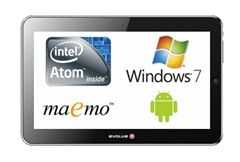 About a year and a half ago I looked deeper into Intel’s Moorestown to report on some of the key features. One of those features was power gating which could significantly reduce the power drain of the platform by turning of areas of the CPU/GPU when they weren’t in use. It’s the feature that brings Intel into the ‘always on’ space but offering a 50x reduction in idle power. The only problem was that Windows wouldn’t run on the Moorestown platform so it was for Meego and Android only.
About a year and a half ago I looked deeper into Intel’s Moorestown to report on some of the key features. One of those features was power gating which could significantly reduce the power drain of the platform by turning of areas of the CPU/GPU when they weren’t in use. It’s the feature that brings Intel into the ‘always on’ space but offering a 50x reduction in idle power. The only problem was that Windows wouldn’t run on the Moorestown platform so it was for Meego and Android only.
Oaktrail, the Z670 and Z650 parts, also have this power gating feature in the same Lincroft CPU and Briertown power management IC that Moorestown offers however, as far as I can see, Intel haven’t ever said that Oaktrail could run at a 50x idle power reduction. It could be that the extra hardware needed for Windows support affects the idle power achievable. Intel have also been quiet about possible battery life advantages of Oaktrail too. We’ve seen encouraging figures but have still yet to see real-life examples of the advantages of an Oaktrail-specific Meego or Android build.
But there still could be some advantages in running and Intel Meego and Android version on Oaktrail due to the extended power states and some claimed battery life figures from Evolve III today show that although there may not be a 50x idle power reduction, there still may be something special that Meego and Android can do to get the best out of the Lincroft/Briertown combination. Evolve are claiming some impressive battery life figures.
We assume that Evolve III are referring to Meego rather than Maemo and we also assume that these are idle or low-usage battery life figures but even so, there’s a clear difference being claimed there.
You can find out more about the Evolve III Maestro S here. We suspect that you’ll see this design popping up under different brands globally. The Viewsonic Viewpad 10 Pro is likely to be using the same hardware so watch out for similar claims for Viewsonic.
Note: Intel are maintaining the OSPM package for MeeGo. We assume that’s the case for their Android build too.
Notes OSPM (Operating System Power Management) is the name of the software feature-set that can interface with the new features and power-states. S0i1 and S0i3 are the unique power-states that the Moorestown and Oaktrail platforms offer.
Note ‘Briertown’ was a working name for the power management IC. Compatible IC’s are available from Renesas, Freescale and Maxim. More information below.











While interesting, i worry what kind of price tag will come along with such a beast.
In a demo at Computex a rep said it would be $750 au.
I was actually considering doing something like this on my blog do you have any references?
Too big, pass.
Hi Chippy,
Have you heard of new viliv 70 which was supposed to be released in April? That one was told to be using the new intel atom processor. Has viliv changed his mind in releasing it? Any news on that?
Maybe they scrapped it in favor of using ARM and Windows 8. Would be great if Viliv was still in the 5 inch device market and made a device with ARM and Windows. Of course, battery life and performance is still unknown when supporting a full desktop OS on ARM with all the extra requirements.
I haven’t heard from Viliv in a long time. Their US phone number closed and they’re not responding to emails. They weren’t even at Computex. I don’t know what’s happening but it does look like they are either closing down, holding back, or are in stealth mode for something special.
I hope they’re not joining OQO and UMID. I’m still holding onto the idea of more 5 inch UMPCs. Microsoft’s Windows 8 announcement gave me a tiny bit of hope for the device category.
That goes to show you can’t just produce excellent products and be hopeful that you succeed. I was always wondering why Apple or Sony don’t make better products while the technology is out there and it is feasible to do that. Now I got my answer. you go bankrupted if you do it.
Floating an intriguing scenario for both Intel and Apple Tuesday, Citigroup analyst Glen Yeung sketched out a scenario Tuesday where Apple could ditch its own processors for chips designed and built by Intel.
Let’s look at the information seems to be pretty useful. thank you